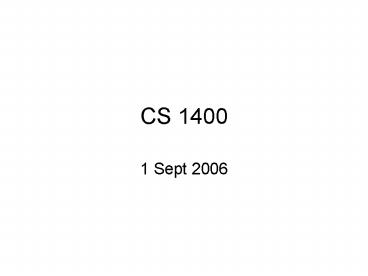CS 1400 - PowerPoint PPT Presentation
1 / 14
Title: CS 1400
1
CS 1400
- 1 Sept 2006
2
Your first C program
- Boilerplate
- // Cannon, demo program
- include ltiostreamgt
- using namespace std
- int main()
- // program goes here
- return 0
3
Output
- Pseudocode
- Print Enter a number
- C
- cout ltlt Enter a number
- Pseudocode
- Print square
- C
- cout ltlt square
4
Input
- Pseudocode
- Get value from user
- C
- cin gtgt value
5
Assignments
- Pseudocode
- Square n n
- C
- square n n
- Pseudocode
- Pay hours 40 (hours-40) Overtime_pay
- C
- pay hours 40 (hours-40) overtime_pay
6
Declarations
- All variables must be established or declared
prior to use usually at the top of the program - Integers are declared using int. For example
- int value
- int width, height, depth
- A variable name must begin with a letter,
followed by letters, digits, or underscores.
7
Pseudocode Example
- Write a program to calculate the volume of a
box, using dimensions provided by the user. - Print Enter height, width, and depth of box
- Get height from user
- Get width from user
- Get depth from user
- volume height width depth
- Print Volume is
- Print volume
8
C boilerplate
- // Cannon, demo program
- include ltiostreamgt
- using namespace std
- int main()
- return 0
9
Adding C instructions
- // Cannon, demo program
- include ltiostreamgt
- using namespace std
- int main()
- int height, width, depth, volume
- cout ltlt Enter height, width, and depth
- cin gtgt height gtgt width gtgt depth
- volume height width depth
- cout ltlt Volume is ltlt volume
- return 0
10
C is case sensitive!
- Use lower case for simplicity
- Upper case or underscore may be used to separate
multi-word variable names - int phone_number // easiest to read
- int phoneNumber // easier to read
- int phonenumber // not as easy to read
11
Extended syntax
- Input and output statements can be cascaded
- cin gtgt height gtgt width gtgt depth
- cout ltlt the value of width is ltlt width
- Declarations can be a list
- int height, width, depth, volume
- Output messages can include control characters
such as \n (new line) and \a (beep) - cout ltlt This appears on line 1 \n This is on
line 2 - Output messages may output endl to force a new
line - cout ltlt this is line1 ltlt endl ltlt This is line
2
12
Chapter 2 issues --
- Key words Table 2.4 (4th edition)
- Gloss over (for now)
- Section 2.3
- Section 2.7
- Section 2.9
- Section 2.10
- Section 2.16
13
Integer variables
- Declaring variables as type int
- Only allows them to hold an integer ( or -)
- Range -2,147,483,648 to 2,147,483,647
- Variations
- unsigned int
- long
- short etcetera
14
Floating point variables
- Declaring variables to be type float
- Allows them to hold an approximate floating-point
value (precision to 6 digits) - Range /- 3.4 x 10-38 to /- 3.4 x 1038
- Constants may be expressed in floating-point
notation or E-notation - E-notation is like scientific notation
- 3.14 x 105 is the same as 3.14E5


























![PDF [READ] Fix-It and Forget-It Big Cookbook 1400 Best Slow Cooker Recipes! Hardcover – Ill PowerPoint PPT Presentation](https://s3.amazonaws.com/images.powershow.com/10150073.th0.jpg?_=20241005036)




